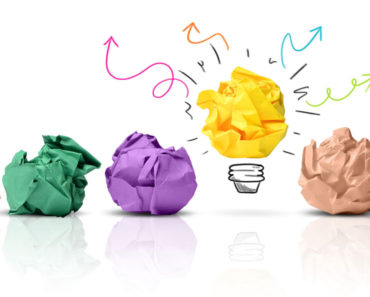You may sometimes find that when facing a challenge or trying to come up with an idea, your brain completely shuts down. This is a common occurrence, especially when you are trying to think in a way that does not come natural to the brain. You see, our brain does not process ideas as a whole, but as a series of thoughts. So, it makes sense that we map out our idea as your mind would.
Think bubbles, or mind maps, as they are more commonly known is our fourth brainstorming technique. This is probably the most common technique of brainstorming used most widely when compared to our other thinking tools. This is also one of the most easiest techniques to use as it is visual and appeals to many, and also because it is very much in synchronization with the way that we think.
Let’s test our brain in action. What do you see in the figure below?

You may at first have thought that it is three triangles, or three groups of four triangles each. Rarely would anyone say that it is a group of 12 triangles, even though that is also true. Our brain would instead, be more comfortable to compartmentalize four triangles into three groups, because that’s how the brain works.
Now if we were to map out our thoughts or ideas in the same way, in different compartments, we would see them in a whole new light. The basic process of thought bubbles is that you start with an initial thought and then branch out from it into different thought bubbles. Similar thought bubbles go together, and you make connections between them. You can use thought bubbles from planning out the simplest of events to the most complex of problems.
Why does it work?
This is a very visual way of mapping out ideas and thoughts and often provide utmost clarity. By compartmentalizing your thoughts, you can deal with them in a manner that is easy on the brain without overloading it.
How do we do it?
Unlike other techniques, this one doesn’t follow a series of steps. It is quite simple to start and execute. What we do recommend is that you do this on a whiteboard if you are in a group. You can also do it on a piece of paper, but it can get limiting due to the amount of space you may require.
Start with a main circle in the centre of your board or paper. This is your main problem or idea or challenge. From this circle, we will branch out into different sectors. If you are facing a problem you could start with the classic questions: who, what, when, where, why, how. Or you can simple take your own direction. Categorize your idea into different branches, then have branches come out of those branches. The whole idea is to branch out your thoughts in the way they are coming to you naturally.
As usual, we will take an example to illustrate this technique.
Let’s take a very simple non-business example this time that everyone can relate to.
Let’s plan a trip to Europe using thought bubbles. Planning trips can get really hectic, and most people resort to some form of checklist. Checklists are great, until you find out there were some items you forgot to add to the checklist. But if we start with a mind map, we can actually create even better vacation checklists and are likely to not miss much.
Since this is just an example, we will go through a full mind-mapping process but will not go into full details.
Let’s start with our thought bubble in the centre and call it “Eurotrip”.

Let’s use the basic questions to further help our thinking process: The W questions. The W questions help to enhance the thinking process, while covering all aspects of your event, idea or problem.

Next choose a thought cloud and expand on it. Each item becomes its own cloud which you can keep expanding on, until you reach a layer where you don’t need any more clarification.

Basically, you keep expanding each thought bubble into more thought bubbles. You can even connect thought bubbles that have a direct relationship with each other.
Let’s see a further version of this:

This is still not a complete mind map for a trip, but it’s a great start, and things are finally coming together in an easy to understand format. As you can see, it can really become complex, while remaining clear at the same time, which is why we initially suggested that you start with a bigger space.
Why are think bubbles so great?
Besides being super easy to understand and work with, and being visual for those who need visual clarity, the best part about mindmaps is that you can erase any thought bubble if it doesn’t fit anymore. Because everything is in its own space independently, you can make changes very easily without affecting the rest of the thought process. Of course, group of bubbles will go away when a main bubble with branches goes away, but those branches may not be relevant anyway, if the main bubble does not exist anymore.
This technique does wonderfully in group meetings and brainstorming sessions, particularly for planning on new activities, assigning tasks to team members or just laying out a new event plan. It is also extremely simple to execute and light on text, while being extremely clear at the same time. Thought bubbles are also very easy to grasp and understand even if you were not a part of the team, and it makes it very easy to explain a concept to someone else. Hence think bubbles or mind maps can also be used in presentations when unveiling a new idea of a product of service. It shows the flow of processes, it shows assignment of responsibilities, time lines, and anything else that you want it to show.
So, the next time you find yourself chairing a brainstorming session, start with a bubble.






